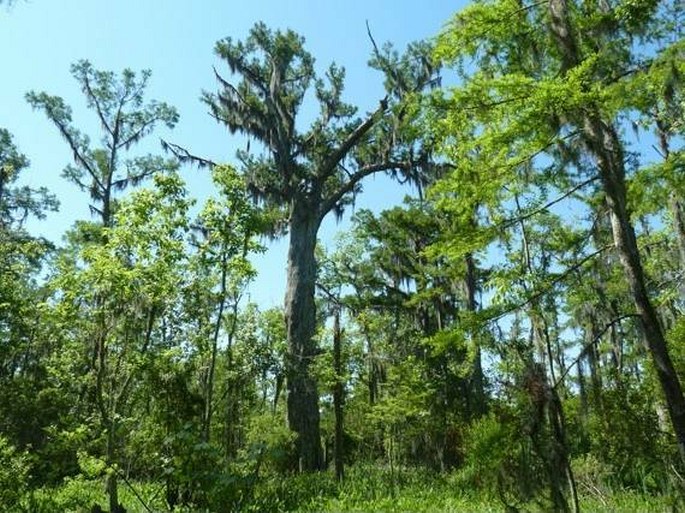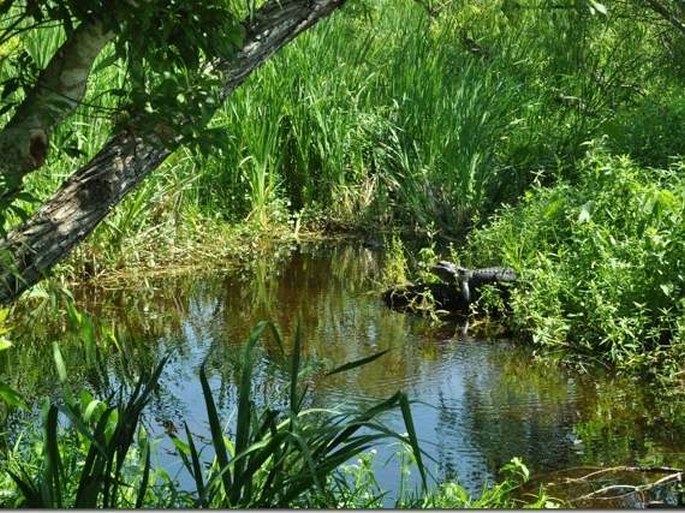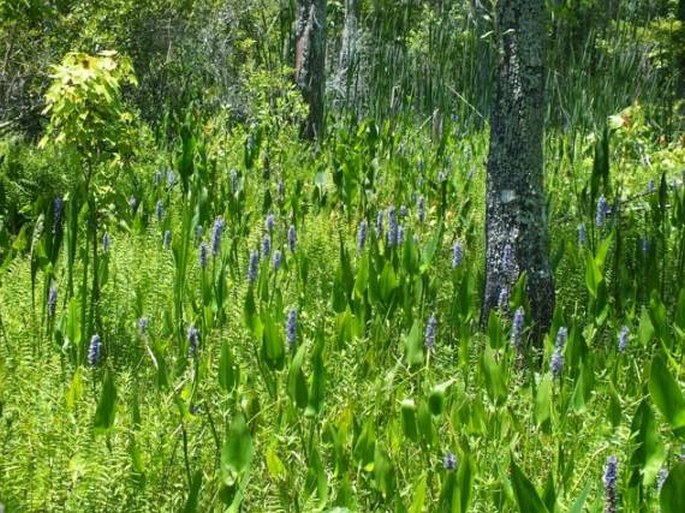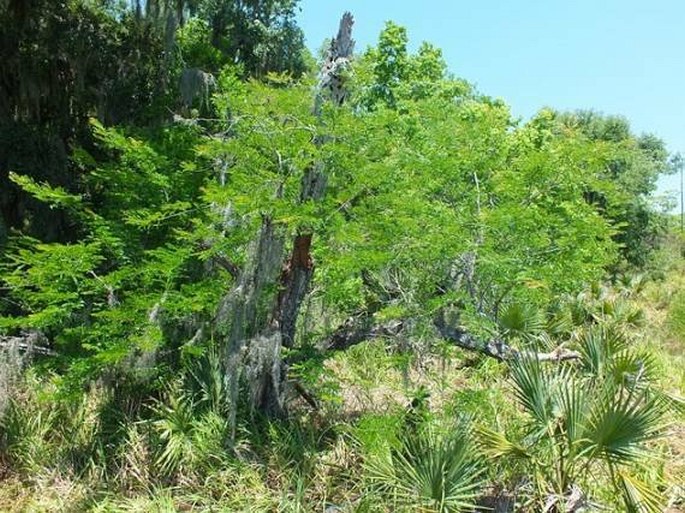While visiting New Orleans and enjoying its history, culture, Mardi Gras, drinking and variety of local music, all nature oriented people would naturally want to see the wetlands and magic of the Mississippi Delta. And the history and the swamps are to be found in Jean Lafitte National Park and Preserve.

You can find history around every corner, on every bayou, from the first steps of Europeans in this area and native tribes preceding them, French at the beginnings, brief period of Spanish rule, reversion to French, Louisiana Purchase by US from French, the war of 1812, the Battle of New Orleans, The Chalmette Battlefield, in which the privateer pirate Jean Lafitte joined forces with the future president of USA, Andrew Jackson and defeated British forces. Andrew Jackson has a large statue in Jackson Square in New Orleans and Jean Lafitte has a national park in the wilderness he used to hide in, Barataria Bay.

The park itself covers over 80 square kilometeres of wetlands, which was the Mississippi Delta about 1500 years ago. Evidently the delta shifted at least 6 times during the last 7000 years, creating this swampy coast of southern Louisiana. Barataria Bay is a classical example of this coastal area and you can investigate it in this national park in Barataria Preserve.
Through the swampy areas you can walk with dry feet on a wooden boardwalk and that way you can avoid the use of a boat and getting lost in this irregular landscape of swamps, bayous, marshes and forests. Otherwise dirt trails wind through the drier areas of the preserve.

Wetlands are the prime habitat for amphibians and of course you can see up to 20 species of frogs, toads, newts and salamaders. Among 12 species of lizards most noticeable are skinks and Green Anole (Anolis carolinensis). Full 10 species of turtles can be seen, from softshells to mud turtles, box turtles and 2 species of snappers. Most numerous are the snakes but they are not the easiest to see. Water snakes, of course, from non-venomous Nerodias and Sirtalis to dangerous Water Moccasin / Cottonmouth (Agkistrodon piscivorus) and dry land snakes like rattlesnakes, 2 species of Milksnake (Lampropeltis) and even a tree snake, Rough Green Snake (Opheodrys aestivus). Do not forget the largest predator, American Alligator (Alligator mississippiensis) which is worth the trip by itself.
If you are lucky you can see some mammals besides squirrels, Nine-banded Armadillo, maybe a White-tail Deer or a Coyote. There are over 200 species of birds here, therefore, it is a special place for birders. You cannot miss 2 species of pelicans, various egrets and herons and even some colourful little birds like a fire-red Cardinal or a brilliant yellow Prothonotary Warbler.

The dominant trees of this area are mostly Bald Cypress (Taxodium distichum), Sweet Gum (Liquidambar styraciflua), Tupelo Gum (Nyssa aquatica) and Black Gum (Nyssa sylvatica). Besides Live Oak (Quercus virginiana) you can identify 13 more species of oak (Quercus) in Louisiana and some of them you find here. There are a number of species of hickory trees (Carya) like Swamp Hickory (Carya glabra var. hirsuta) or Shagbark Hickory (Carya ovata). 4 species of Magnolia occur here, 2 species of Mulberry (Morus), 6 species of Elm (Ulmus), Witch Hazel (Hamamelis virginiana), 3 species of Ash (Fraxinus), 5 species of Maple (Acer), 5 species of Pine (Pinus), and among the shrubs, 3 species of Holly (Ilex), 3 species of Dogwood (Cornus). Southern Dewberry (Rubus trivialis) is a sprawling, thorny shrub which can supply you with refreshing fruits.
Omnipresent palm is Dwarf Palmetto (Sabal minor) barely reaching 3 m height, with an underground trunk. Chinese Tallow (Triadica sebifera) represents invasive tree species and is found on the banks of the canals.

Wild flowers abound. Depending on the season you can see a variety of plants which are associated with fresh marsh and brackish marsh. These soils are described as level, very poorly drained, very slowly permeable, saline organic soils with decomposed herbaceous plant material.
The grasses (Poaceae) are abundant and the count can reach 100 species. Cyperaceae are well represented with at least 20 species of Carex, many of Cyperus, Schoenoplectus, Eleocharis and Scirpus. Due to the nature of habitat with sluggish water present, there is a variety of submerged and floating vegetation which includes genera like Lemna, Wolffia, Vallisneria, Azolla, Salvinia, Najas and Nymphaea. Of the ferns, Southern Woodfern (Dryopteris ludoviciana) and Royal Fern (Osmunda regalis var. spectabilis) are the most conspicuous.

Speaking of conspicuous, large areas are covered by Pickerelweed (Pontederia cordata) with its beautiful blue flowers. Lizard’s Tail (Saururus cernuus) can be found in large patches as well, with its white inflorescences with drooping tips. Broadleaf Arrowhead (Sagittaria latifolia) is showing its pretty white flowers among the other vegetation. In early spring you can find Louisiana Marsh Spider-lily (Hymenocallis liriosme) in the bloom and wonder about the beauty of its flowers. In summer you can admire the similar Spider-lily (H. occidentalis).
Nobody can forget the iconic plant of the South, Spanish Moss (Tillandsia usneoides) which is the only bromeliad here, but festoons all the large and small trees of this great swamp.
The invasives are also present. Many of the older canal ways within the Preserve become choked with invasive vegetation. Salvinia minima (Water Spangles) and Eichhornia crassipes (Common Water Hyacinth) often outcompete native vegetation. South American immigrant Alligator Weed (Alternanthera philoxeroides) is present almost everywhere.

Sample list of Barataria flora:
Acacia farnesiana
Acer negundo
Acer rubrum var. drummondii
Amaranthus australis
Ambrosia artemisiifolia
Ambrosia trifida
Asclepias perennis
Atriplex pentandra
Bacopa monnieri
Bulbostylis ciliatifolia
Cabomba caroliniana
Campsis radicans
Canna glauca
Carex abscondita
Carex alata
Carex amphibola
Carex aureolensis
Carex blanda
Carex cherokeensis
Carex comosa
Carex corrugata
Carex crus-corvi
Carex festucacea
Carex hyalinolepis
Carex leavenworthii
Carex longii
Carex texensis
Carex tribuloides
Carpinus caroliniana
Carya aquatica
Cicuta maculata
Clematis crispa
Colocasia esculenta
Commelina diffusa
Conyza bonariensis
Cornus drummondii
Cucurbita pepo
Cyperus croceus
Cyperus elegans
Cyperus erythrorhizos
Desmodium canescens
Eleocharis cellulosa
Eleocharis vivipara
Epidendrum magnoliae
Eryngium prostratum
Erythrina crista-galli
Eupatorium perfoliatum
Euphorbia hyssopifolia
Euphorbia spathulata
Fraxinus pennsylvanica
Fraxinus profunda
Galium aparine
Geranium carolinianum
Gleditsia triacanthos
Habenaria repens
Hibiscus lasiocarpos
Hydrocotyle umbellata
Hymenocallis liriosme
Hymenocallis occidentalis
Hypericum mutilum
Ilex cassine
Ilex decidua
Ilex vomitoria
Ipomoea imperati
Ipomoea sagittata
Iris fulva
Iris virginica
Juncus acuminatus
Juncus polycephalus
Lactuca floridana
Landoltia punctata
Lemna obscura
Liquidambar styraciflua
Lithospermum tuberosum
Ludwigia leptocarpa
Magnolia grandiflora
Magnolia virginiana
Mimosa nuttallii
Mimosa strigillosa
Mimulus alatus
Myosotis macrosperma
Najas guadalupensis
Nelumbo lutea
Nyssa aquatica
Oxalis violacea
Packera glabella
Passiflora incarnata
Persicaria virginiana
Phytolacca americana
Pistia stratiotes
Platanus occidentalis
Pleopeltis polypodioides
Pontederia cordata
Populus deltoides
Potamogeton pusillus
Prunus serotina
Pyrrhopappus carolinianus
Quercus laurifolia
Quercus nigra
Quercus texana
Quercus virginiana
Ranunculus pusillus
Rubus trivialis
Rumex verticillatus
Sabal minor
Sagittaria latifolia
Sagittaria platyphylla
Salix nigra
Salvia coccinea
Sanicula canadensis
Saururus cernuus
Schoenoplectus pungens
Scirpus lineatus
Sesbania drummondii
Sesbania punicea
Sisyrinchium angustifolium
Sisyrinchium rosulatum
Smilax rotundifolia
Solanum carolinense
Solidago altissima
Spiranthes odorata
Spiranthes vernalis
Stachys crenata
Symphyotrichum lateriflorum
Taxodium distichum
Thalictrum dasycarpum
Tillandsia usneoides
Toxicodendron radicans
Tradescantia virginiana
Triadica sebifera
Triodanis perfoliata
Typha domingensis
Typha latifolia
Ulmus americana
Vallisneria americana
Verbena scabra
Veronica peregrina
Vicia ludoviciana
Viola sororia
Vitis rotundifolia
Wolffia columbiana
Wolffiella oblonga



